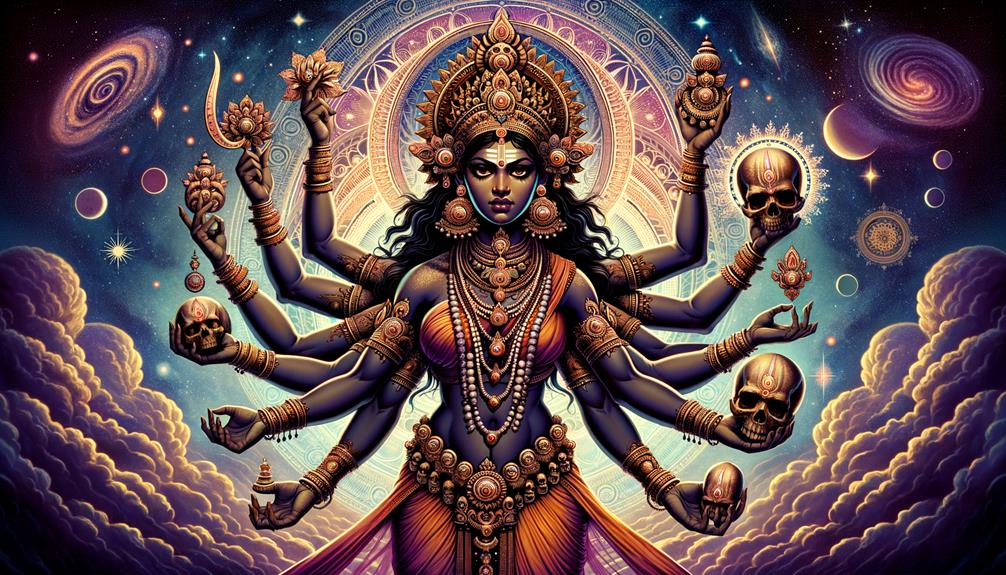Deep within the fascinating world of Hindu mythology, Kali, the dark goddess, resides. She's depicted with her tongue out, adorned with a necklace of skulls, and covered in blood. It's easy to misinterpret her imagery. She's a puzzle within a conundrum – a symbol of death, destruction, and chaos, yet at the same time, she represents life, love, and salvation. As we decode her myths, her symbols, and what she stands for, we find ourselves facing not just the many layers of the goddess herself, but also the complex network of cultural and philosophical views that formed her image. So, are you prepared to set off on this journey? It's not just about understanding Kali, but about understanding the complexities and contradictions that form the human experience. Are you geared up to tackle these enigmas, to dive deep into the mysteries of the dark goddess?
Kali's Role in Hindu Mythology

If we dig into Hindu mythology, we come across the intriguing figure of Kali, a layered goddess who encapsulates the full spectrum of life, death, and the cyclical rhythm of being. Known as the goddess of time, she's a stark reminder of how fleeting our earthly lives can be. In her narratives, she's often seen as a formidable force against evil, notably in her battle with the demon Raktabija (Blood-Seed). This demon had a unique power – every drop of his blood that touched the ground would create another Raktabija, making him almost unbeatable. But Kali, in her divine wisdom, figured out a way to defeat him by sticking out her tongue to stop his blood from hitting the ground, thus defeating him.
But Kali's role in Hindu mythology is more than just a destroyer. She's also seen as a symbol of creation and preservation, being the partner of the god Shiva, one of the three main gods in Hinduism responsible for these aspects of being. Her intense depictions, where she's seen wearing a garland of skulls and dancing on Shiva's lifeless body, highlight the endless cycle of life and death, creation and destruction. So, the Hindu goddess Kali serves as a deep reminder of the unavoidable cycles of existence.
Symbolism Behind Kali's Fierce Form
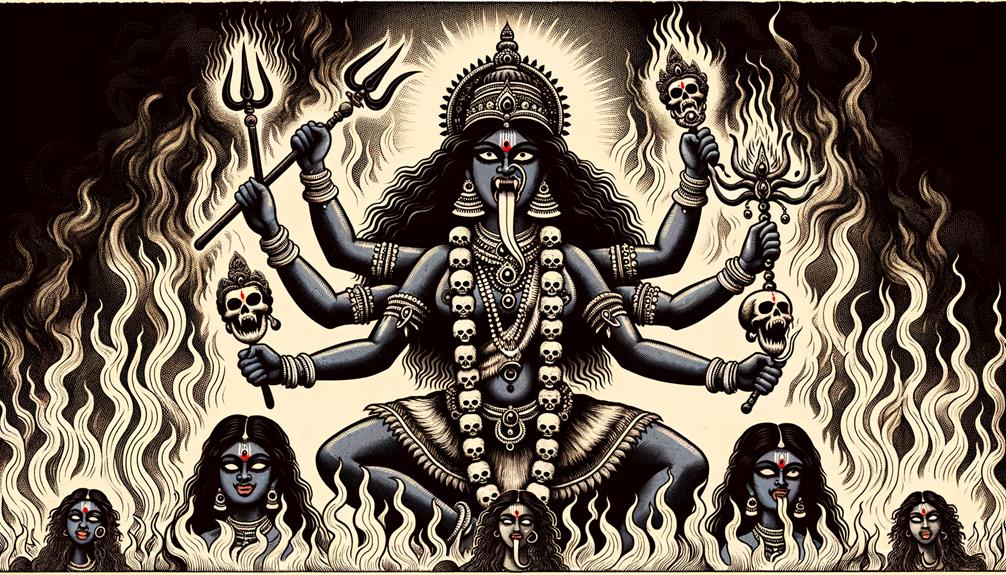
Let's dive into the rich symbolism behind the fierce form of Kali, the black goddess. Known as Kali Ma, she embodies the feminine aspect of Kāla, which stands for time, death, and destruction.
Now, let's take a closer look at some key aspects of Kali's fierce form:
- Severed Heads – Have you noticed the necklace of decapitated heads she wears? And the sword and severed head she holds? These represent her reign over life and destruction.
- Extended Tongue – Her protruding tongue isn't just for show. It stands as a symbol of her relentless desire for battle and her victory over evil.
- Relationship with Shiva – Ever wondered why Shiva is lying under her feet? It signifies a balance of power and control, with Shiva acting as a calming influence on Kali's ferocity.
- Victory over Raktabija – Her win over the demon Raktabija showcases her ability to put a stop to the spread of evil and chaos.
Through these stories and interpretations, Kali isn't just seen as a symbol of destruction. She's also viewed as a protector and a perfect example of female empowerment. Kali serves as a reminder of the inherent power within each of us to create and destroy.
The Legend of Kali and Raktabija
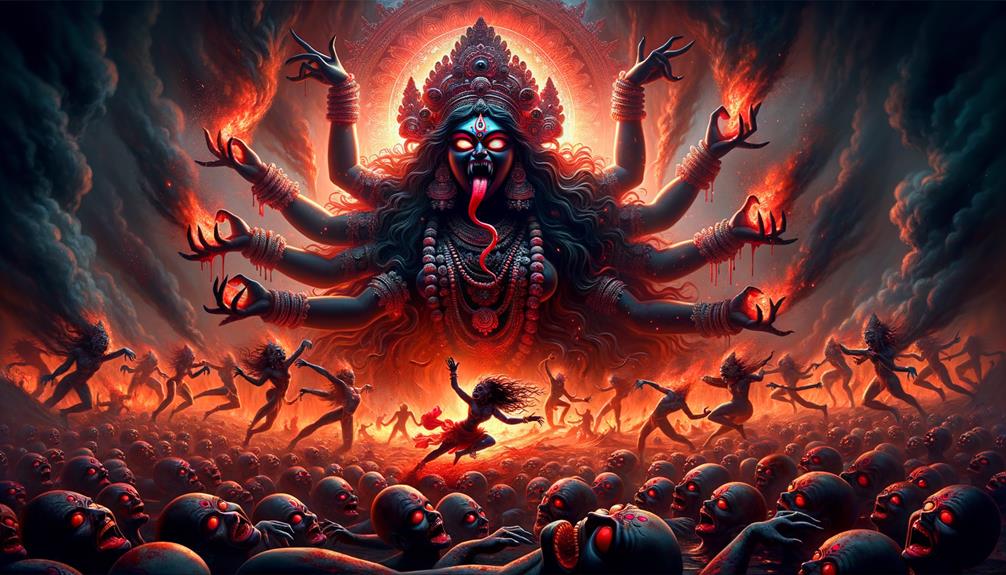
Let's chat about the fascinating story of Kali and Raktabija, where Kali, the Hindu goddess of death, showcases her strength and power as the guardian of the world. The tales surrounding Kali are filled with intriguing, layered meanings.
The tale begins with Kali, born from the fury of goddess Parvati, stepping up to defeat the demon Raktabija. Her inventive approach included consuming all the blood on the battlefield, which stopped Raktabija from creating more of his copies. While this might sound a bit grim, it's actually a testament to Kali's determination and her unwavering commitment to safeguarding the world.
The story continues with Kali's battle intensity being soothed by her partner, Shiva. Their relationship is dynamic and illustrates how even Shiva, a mighty deity himself, leans on Kali's strength. This highlights her immense power even more.
The tale reaches a high point with Kali holding the severed head of Raktabija, a potent symbol of overcoming evil. But the story isn't just about a physical showdown. It also narrates a spiritual victory, reminding us of human sacrifices to Kali and the obliteration of personal demons. It provides deep understanding into the enigma that is Kali – a goddess of death who is also a protector and liberator.
Worship and Controversy Surrounding Kali
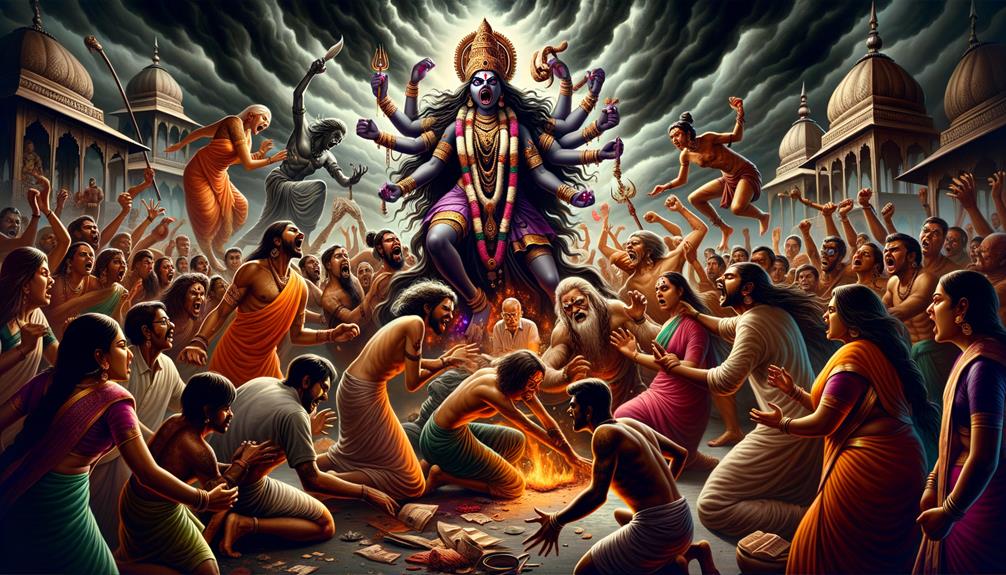
Kali, with her intriguing blend of reverence and controversy, represents the very essence of nature's dual forces. She's both destructive and kind-hearted, going beyond the usual concepts of right and wrong. This contradictory nature shines in the Kali Puja festival, where followers gather at her temple. They pay their respects by adorning her statues with red sindoor, a symbol of their deep devotion.
But Kali isn't without controversy. The notorious Thuggee cult, infamous for their crimes, believed that they could gain her protection through human sacrifice. Animal sacrifices, too, have been associated with her, although most have stopped this practice today. However, these past associations still cast a shadow on her image.
Here's what you need to keep in mind about Kali's worship:
- Despite her fierce representation, she's often revered as a motherly protector.
- Kali Puja, a major festival in Hinduism, is dedicated to her.
- Her transformative power is emphasised in Tantric teachings, using her destructive side for spiritual advancement.
- Modern-day followers focus on her benevolent side, leaving behind violent practices like animal sacrifices despite the historical controversy.
To truly grasp Kali, you need to recognise her multifaceted nature. She's a goddess, yes, but there's also an element of controversy that comes with her.
Kali's Influence Beyond Hinduism
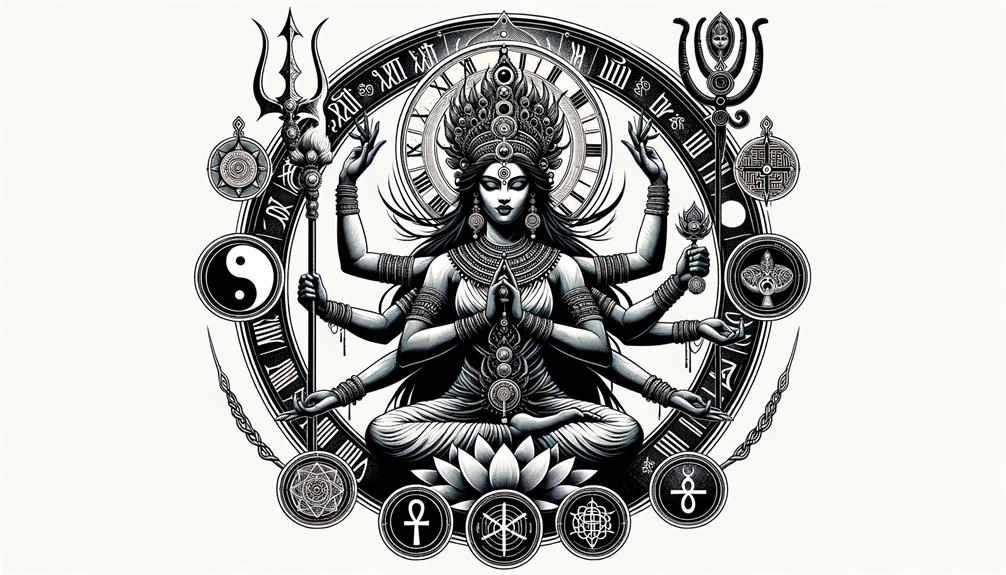
Looking beyond her Hindu origins, we find it interesting to see how Kali's worship has made its way into other faiths such as Paganism and modern Tantrism. This has led to her increased acknowledgement as a powerful symbol in the 20th and 21st centuries. Her influence can also be seen in the new age movement, where she stands as a symbol of female strength, a subject that resonates with feminists around the globe.
Kali's roots in Hindu symbolism present her with different skin colours and clothing, indicating her various interpretations globally. Despite these variations, Kali's core identity remains consistent – a mighty goddess representing the transformative power of destruction.
In modern Tantrism, Kali's sexual elements are applied for therapeutic reasons, further extending her influence. Her name, linked with dark, turbulent but transformative energies, is found in rituals, practices, and beliefs beyond just Hinduism.
In our journey to understand her, we must recognise Kali's dual nature. She symbolises both the creation and the inevitable end of life. This contradictory duality has helped maintain her importance and relevance, not only within her native Hindu tradition but also across different cultures and spiritual practices worldwide.
Frequently Asked Questions
What Is the Myth of Kali the Goddess?
Kali is a pretty fascinating goddess, representing both creation and destruction. She simply transcends notions of good and evil, and let me tell you, she is fiercely protective of her children. One popular tale describes her triumph over the demon Raktabija, and it's quite a story – she actually drank up all the blood on the battlefield to ensure her victory.
What Does the Kali Symbolize?
From what I gather, Kali signifies the two-fold aspects of existence: life and death, creation and devastation. She embodies both the nurturing and the fierce, going beyond the simplistic notions of good and evil. Being a divine representation of feminine power, she's raw, potent, and works as a guardian.
What Are the Stories About the Goddess Kali?
The tales of Kali, the goddess, are incredibly diverse and intriguing. They touch on various aspects of her life, such as her emergence from Durga, her triumph against Raktabija, and her complex association with Shiva. These narratives underscore her unique identity – she is both, a force of destruction and a guardian angel.
What Is the Story Behind Kali?
Have you ever wondered about the story of Kali? Well, the tale of Kali is all about the cycle of creation and destruction. In Hindu mythology, she is the partner of Shiva, and often acts as the catalyst for his unpredictable actions. One of the most remarkable moments in her story is when she takes down the demon Raktabija. She achieves this feat by drinking the blood on the battlefield to stop the duplication of the demon. Her influence is particularly strong in Bengal, where she is worshipped by many. Kali is synonymous with power, a symbol of immense strength and authority.

